► The inside story of Race of Remembrance 2021
► CAR joins Morgan’s works Plus Four team
► A race that can change lives for the better
Wind howls across the Irish Sea and lashes Anglesey’s clifftops. Spectators hunch their shoulders and pull their coats tighter. The bitingly cold breeze whips straight into the Morgan Plus Four’s open-sided cockpit, battering my shoulders as they steer a course through fading light.
High-intensity spotlights mounted on the car’s hardtop cut through the murk, illuminating a circuit packed with dicing cars: two battling BMWs ahead, door mirror to door mirror in a synchronised four-wheel drift; further up the track, a pair of Citroen C1s nose to tail in their own private battle, tiny wheels splayed into odd camber shapes as they corner slightly beyond their manufacturer’s intended limits; and a Caterham streaks around the outside of them all, two wheels kissing the grass. Its driver’s hands flicker to opposite lock, illuminated in the glow of lights mounted on its rollcage.
I’m halfway through my first racing lap, and there are another 10 and a half hours to go. Welcome to Race of Remembrance.
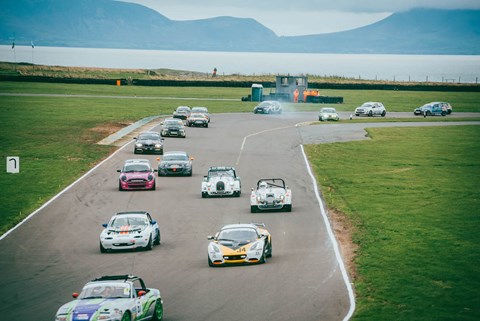
All viewed from the classiest seat in the house. The Morgan Motor Company has entered two works Plus Fours in RoR 2021, one an automatic with hand controls, driven by Mission Motorsport charity beneficiaries – more on that in a moment – and one manual, with CAR among its four drivers.
‘On Sunday morning, the cars roll to a halt, engines fall silent and all congregate for a service of remembrance’
Rewind back to the beginning of the weekend, and both gleaming Plus Fours are tucked away from the elements in Anglesey’s pit garages as we wait for qualifying to begin. Holding a 12-hour endurance race (split into two six-hour halves, over Saturday and Sunday) in the ice-cold embrace of November at one of the UK’s most weather-beaten (if beautiful) venues is part of the combative spirit of Race of Remembrance.
Created by the forces’ motorsport charity Mission Motorsport, it’s an annual flagship event that brings together people from all corners of the military, sporting and automotive world. Fundraising is only a small component of the event’s purpose; it’s an opportunity for people to come together and unite for a common purpose, to celebrate and support. The race provides charity beneficiaries with on-the-job training and with opportunities to race, and, most importantly, it also incorporates a full Remembrance Sunday Service.
At 10.45 on Sunday morning, the cars will roll to a halt, engines will fall silent and all present at the circuit will congregate in the pitlane for an 11 o’ clock service of remembrance. Respects are paid, and the race continues. In the words of Mission Motorsport founder CEO James Cameron, it’s a memorial service with a race attached.
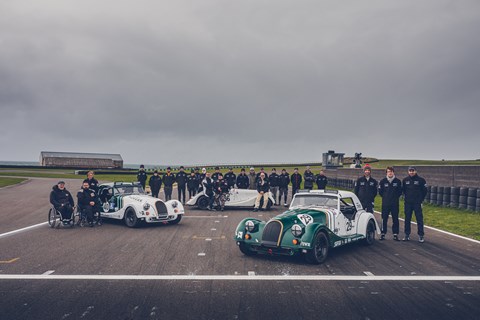
Morgan is becoming part of the fabric of the event. The Malvern sports car manufacturer has been involved for the past four years, and this year it’s chosen RoR to be the race debut for the new Plus Four, launched last year.
It’s here partly to show the new sports car off, partly to prove its reliability and partly as a test-bed: ‘The best learning you get is from racing, for components’ longevity,’ says CEO Steve Morris (pictured below). ‘You break things that you wouldn’t break on the road. The most these cars have done prior to this weekend is 30-minute shakedown stints, not hard driving. And they’re out-the-box road cars…’
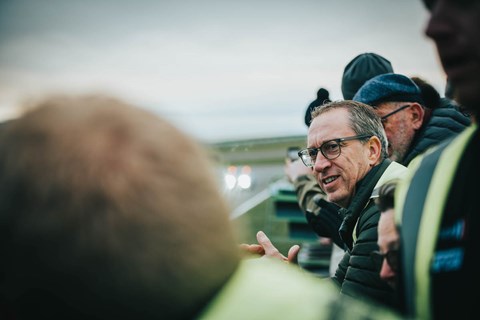
‘Binns is controlling the brakes and throttle with one hand’
There’s another part Morgan is playing. It’s teamed up with Mission Motorsport to give racing opportunities to three beneficiaries with life-changing injuries. Lionel O’Connor, Steve Binns and Linda Noble, alongside journalist John Hogan, are driving the hand-control-equipped auto Plus Four. Lionel has raced at RoR twice previously and is something of a dab-hand behind the wheel. Having lost his left leg above the knee in Iraq, he runs Mission Motorsport’s car control team, teaching people how to get a car into, and out of, a slide safely. When he drove an automatic Honda Civic road car, he noticed the transmission wasn’t responding quite as he’d like it to; a conversation with engineers at Honda led to a remap for the transmission with a new line of code – known internally at Honda as the ‘Lionel code.’
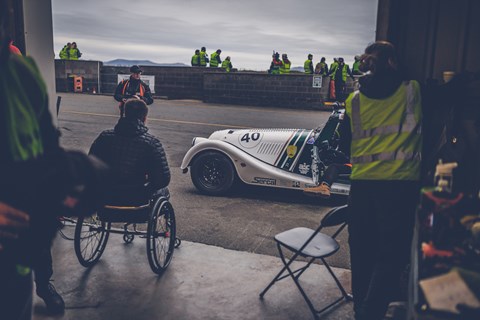
For Steve, Linda and John, however, it’s their first ever race. Talk about a baptism of fire (and rain). ‘Transitioning into the car for driver changes during the pit-stops is the trickiest thing for us,’ Steve explains, ‘because of the range of disabilities in the team, and different sizes of people, we need different sizes of belts for different drivers.’
Steve is without the use of his legs, and while Lionel uses his right foot to switch from throttle to brake, Steve is controlling the 255bhp, traction-control-free Plus Four’s throttle and brakes entirely with the pull-to-go, push-to-stop lever. Their car’s crew, made up of Mission Motorsport personnel, motorsport engineering students from Wolverhampton University and experts from the Morgan factory, work tirelessly in repeat rehearsals to find the most efficient and safe way possible to ensure every driver fits perfectly, and can enter and exit the car safely.
‘The view ahead is all flowing fenders and vented bonnet’
Aside from the two works Plus Fours, there’s also a further Morgan Clubsport, in a special poppy livery, which owner John Richards has entered for beneficiaries to drive. It too is being run by a blend of Mission Motorsport personnel, students and Morgan Motor Co. crew. A further privateer Morgan Clubsport is out there too, so altogether there’s a quartet of Malvern’s finest battling around Anglesey.
They look fantastic, especially the Plus Fours to my eyes. Their green and white liveries, designed by a talented student, are inverted between the two cars: the manual car, no.29, has a green nose and white tail, and auto no.40 an inverted green front and white rear.
I’m in very good company in car 29: Shane Kelly won this year’s Formula 3 Cup and heads up the University of Wolverhampton’s racing programmes; Tom Richards is youthful but cut his racing teeth in Morgans and can get them round a circuit very quickly; and affable, multi-talented Tony Hirst (below) is a TV actor, voiceover artist and also a very handy Morgan racer in his spare time.
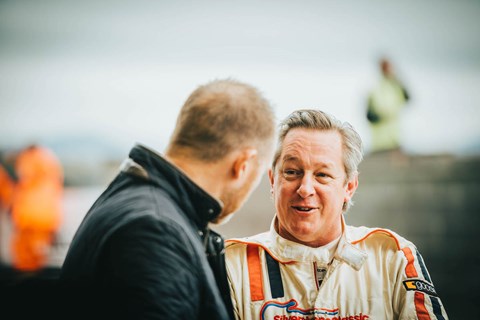
Time to roll the garage’s shutter up and get out there for qualifying. I’m first out, and car 29 instantly feels at home. Just like in the Plus Four road car, the view ahead is all evocative flowing fenders and vented bonnet, framed through an upright windscreen with three dinky (but effective) chrome wipers. Except you’re sat that bit lower, tightly harnessed into a racing seat, and with an extra set of shift-lights ahead of the race-spec wheel in addition to the usual centre-dash-mounted rev-counter, the better to keep your eyes where they need to be.
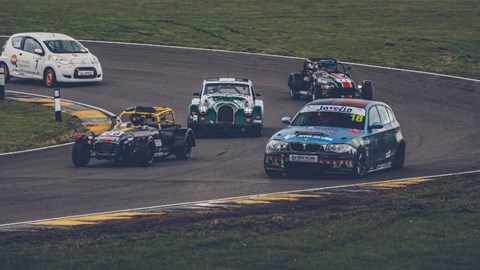
Mine are out on stalks at the moment: there are 50-odd cars out here, and the Morgan’s seeing a lot of them, as it’s fast enough to lap two thirds of the field. Like the road car, it’s powered by BMW’s four-cylinder 255bhp single turbo B48 engine. And, like the road car (which weighs little more than a tonne) it’s seriously accelerative.
The sheer variety of metal out here is amazing; with classes arranged primarily by power-to-weight ratio, and with slick tyres and sequential gearboxes currently outlawed, there’s everything from Citroen C1 to Civic Type R, Cayman to Caterham, Mini to MX-5 sharing track space.
The lack of a limited-slip diff is one of the Plus Four’s few downsides, spinning its inside wheel readily out of Anglesey’s long, open hairpins if you’re greedy with the throttle. But otherwise, with its stiff bonded aluminium structure and all-round double-wishbone suspension, the Plus Four handles sweetly and stably. The long-legged gearing means you’re in third for the majority of the lap, grabbing fourth once on the curving back ‘straight’ and snicking second only for the tight Rocket complex and far hairpin.
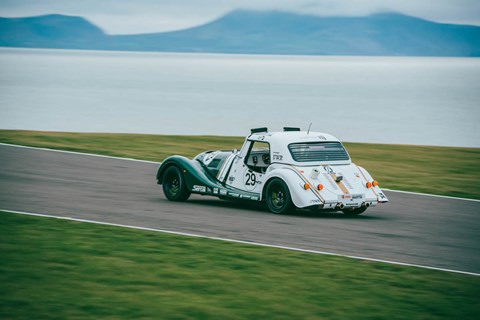
The power steering (Morgan’s own) is very light, which makes the car far from taxing to drive. The one time I’ve raced in RoR previously, with Caterham in 2018, my gearchange shoulder was aching for a day or two afterwards, but I still feel fresh when I pull into the pits (loosen your belts as you roll to a halt, wait half a beat for the radio to be unclipped, then scramble clear through the rollcage) to hand over to Tom.
You can read our adventures in the 2018 Race of Remembrance here
We’re going well, and when the flag falls we’re 15th overall. Few cars are quicker in a straight line but we can’t quite live with the Caterhams’ and Lotus Elise’s sheer corner speed and traction. Reinforcing Morgan’s aim to prove the Plus Four’s reliability, the two cars are broadly standard, with the most visible mods rollcages, competition-spec fuel fillers and semi-slick tyres (and the LED spotlights for racing at night). It’s an impressive showing, and the auto car, with three quarters of its drivers in their first qualifying session of any kind, has qualified a superb 29th.
These two cars are also the first racecars to be built on Morgan’s CX platform, the aluminium structure that underpins the Plus Four, its six-cylinder Plus Six big brother and will form the basis of other future Morgan models. It chose the Plus Four as the base for the first CX race car rather than the Plus Six as, with a power-to weight ratio of around 250bhp, it’s eligible to race in more series (including the factory-sanctioned Morgan Challenge – and RoR).
Morgan’s in its sixth year of partnership with the University of Wolverhampton, and the Plus Fours have been race-prepped with the help of motorsport engineering students. Car 29 is crewed almost entirely by second- and third-year students, doing a spot-on job. Morgan has a strong culture of apprenticeships, and several graduates have found jobs at the company, just as ex-forces personnel may in the future with Morgan having recently signed an Armed Forces covenant opening the potential to recruit. Morgan CEO Steve Morris, watching on keenly from the pitwall, began as an apprentice in the metalshop himself.
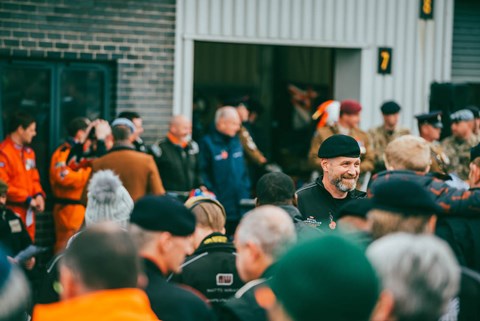
Also watching on in the pitlane is Mission Motorsport CEO James Cameron. ‘It’s just so good to be here,’ Cameron says, glancing proudly down the pitlane, packed with all shapes and sizes of cars, like a cross-section of UK club racing. Race of Remembrance didn’t happen last year; the pandemic put paid to carefully laid plans. This year it’s a sell-out, and the capacity grid of 53 cars is the biggest yet in the race’s eight-year history.
‘The thing that’s changed in the last few years is just how much it’s grown. It’s become more of a movement than a single event at Anglesey. It’s now how we go about motorsport in the UK on Remembrance Sunday: at every event, you observe the silence, support the poppy appeal and maybe more. The BritCar championship at Brands Hatch this weekend will be suspending the racing for a memorial service too.’
A movement of separate activities, posted online with the tag #YourRoR, took place last year in lieu of the cancelled race. That’s gathered pace and continued, and a separate karting race is happening concurrently in Hampshire this year alongside the full-scale RoR at Anglesey.
‘Each reflective element on the Exige’s body panels represents a life lost in Afghanistan and Iraq’
Cameron has driven to Anglesey directly from Lotus’s Norfolk HQ in this year’s ‘Poppy Car,’ an Exige wrapped in a livery designed by former servicemen and women. It’s also topped by yellow flashing lights, as it’s this year’s safety car.
The Poppy Car has become an integral part of Race of Remembrance, the first being a Mazda MX-5 racecar in 2015, and a Jaguar F-Type SVR course car in 2018. Lotus itself has launched an Armed Forces Engagement programme, extending its employment pool to the service community, and Morgan is enacting a similar initiative.
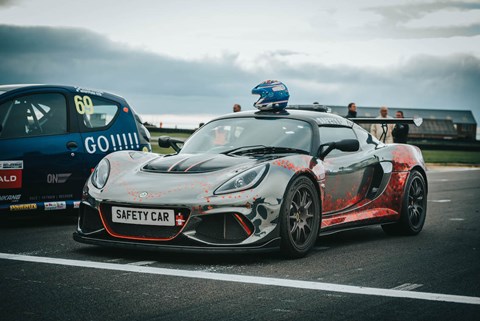
Alongside thousands of hand-placed poppies making up the Exige’s livery, 635 of them are individually cut and placed reflective surfaces, which glow red in the dark. Each of them represents a life lost in Afghanistan and Iraq. ‘It’s a serious message but the Poppy Car is also such a recovery tool for our beneficiaries,’ Cameron says. The team of Mission Motorsport beneficiaries working on the Exige have included those suffering from PTSD and complex injuries from conflict, and many have gone on to employment as a result. Former Green Beret Marc Tarling played an instrumental role in the Exige’s livery: ‘For the first time in a long time I have been able to talk and engage with other people, have confidence in my own abilities, get up in the morning and do something I can take pride in,’ he has explained. From being unable to leave the house for a period of time, suffering from PTSD, he has since worked on major automotive projects overseas.
‘There’s something very British about this blend of barminess and grace’
Race time, but not before the Biathlon of Foolishness. Described as ‘a light-hearted, sporting distraction (and a bit of a fundraiser)’ it involves a half-mile run around the circuit, a detour down the cliffside to the sea, and into it, around a buoy and back to the pitlane. Every team is required to enter a representative (or buy their way out) and the costumes get more outlandish each year; 2021 included a bevy of dinosaur exoskeletons alongside returning Victorian bathing-suited fashions from previous seasons.
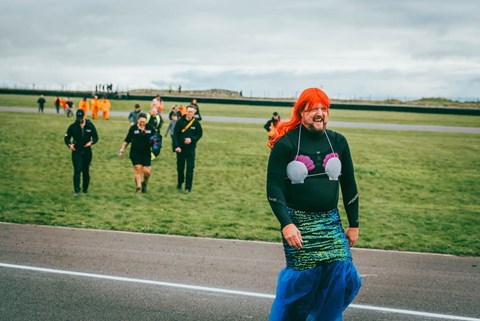
It’s not a race as such but, proving he’s just as quick on his feet as in a racing car, Mission Motorsport beneficiary and racing driver Danny Holland runs (and wades) away with it, finishing some distance ahead of the rest of the runners despite being wearing a full (spare) racesuit.
There’s something very British about the Race of Remembrance, its mix of barminess and stoic grace, and there’s something very apt about the emphatically British, slightly barmy (in a good way) Morgans being a part of the event.
‘Tony pits for the first driver-change, the Plus Four now a scented cocktail of sticky tyres and hot brakes’
Time to start. The Ninth Gunners Regiment bagpipes strike up in the paddock and so do the hairs on the back of my neck. Tony is taking the start in car 29 and Lionel in car 40. As 3pm strikes, the field moves steadily away in formation behind the Poppy Car, before it peels into the pits and 53 engines are raised in song and a headline rush to the first corner.
The opening laps are a blur of cars jockeying for position, drivers torn between going for gaps and playing a cautious long game. In what seems like a flash, 90 minutes are over and Tony’s into the pits for the first scheduled refuelling stop and driver change, the car a scented cocktail of hot brakes and tyres. The students detach the fuel canister, and I’m in, unseen hands buckling my harnesses into place and the radio connection into its socket. First gear, go.
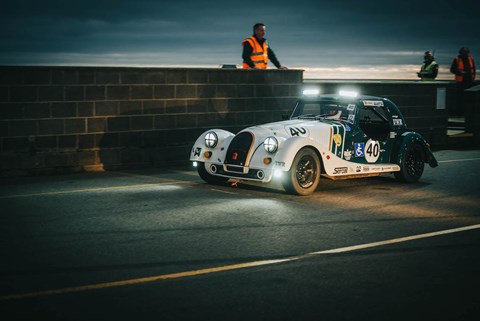
And onto a rapidly darkening circuit. This is where we came in. The Plus Four racecar has a hardtop (styled to echo its ’60s Le Mans class-winning ancestor) but open sides above its low-cut doors, and it’s funny how that heightens your senses. Driving a Plus Four on the road, you can smell fresh-cut grass, surrounding farms, fumes from lorries ahead, food from roadside cafes. In the racecar too there’s the same sensation: if a car ahead locks a tyre under braking, you smell the acrid stench of scorched rubber; if a car’s running rich, you pick up the sooty fumes as you draw closer to it. You even get to know lapped cars’ individual scents as the race wears on.
The super-quick kink on the back straight doesn’t require braking, just a bit of a lift and on this particular lap, the exit kerb’s getting a bit closer than I’d like. Much closer. In fact I’m on the kerb now – now onto the grass just beyond it for several agonising moments and metres before rejoining the tarmac. A sudden flash of white and green ahead of the windscreen: the Plus Four’s elegant centre-hinged bonnet has made a bid for freedom. The bump over the grass has dislodged it, the wind has whipped beneath and it’s taken to the skies like a seabird. Suddenly I’m driving a bonnet-free Plus Four. The car feels fine, but assuming I’ll get a mechanical fault warning flag, I dive into the pits to have the car checked over. We lose at least a couple of laps before I’m back out again.
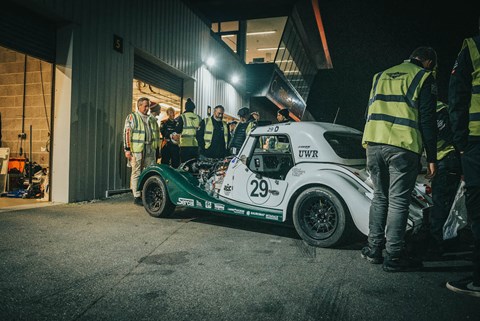
I feel terrible. It’s a race where finishing is everything, and part of the point of Morgan being here is to prove the Plus Four’s reliability. Taking an off-road detour hasn’t helped that mission particularly. But the good news is, the car is absolutely fine and as fast as ever, quickly settling down to laptimes as competitive as before. Phew.
‘The roof-mounted LEDs cut through the murk like a searchlight’
It’s a long stint, and I’m happy to stay out to avoid facing the wrath of everybody back in the pits. That, and I’m really enjoying myself. The beam from the roof’s LEDs cuts through the murk like a searchlight, and the Plus Four is flying. The only cars that occasionally overtake during the stint are the quickest of the Caterhams, and with the Morgan so fast down the straights, they have to do it on the brakes. I find it’s best to work together with them, easing off on a straight to let the front-running Caterhams through, then allowing them to scatter the lapped traffic ahead, like lions hunting a pack of startled gazelles, before tailgating through behind them.
Back in the pits to hand over to Tom – and everyone’s all smiles. The car’s running sweetly and we’re in a good position with good pace. Phew, again.
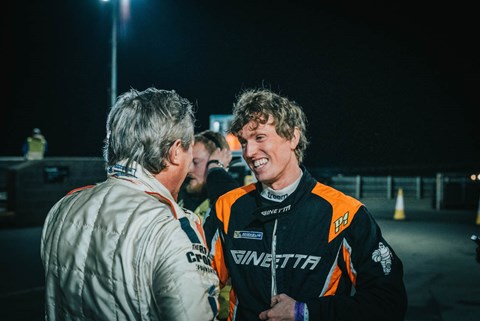
I’ll be back in the car before Part One of the race draws to a close at 9pm. In the meantime, I visit the auto Plus Four team next door to see how things are going. Lionel is relaxed, chatting through highlights from his epic opening stint, where he passed car after car ahead of him. Steve’s just finished his first stint: ‘It’s been absolutely fantastic. You think “just drive your own race,” then you get a car behind you and think, “you’re not coming past…” he grins, wryly. ‘A big marble of tyre debris came flying towards me at one point and in out of pure instinct, I ducked behind the windscreen,’ he continues. ‘I span twice – one was a perfect 360, emerging from my own tyre smoke pointing the right way.’
Keen to keep car 29 pointing the right way, I’m back in for the final run to the chequered flag, taking over from Shane who’s run most of his stint in the dark after gremlins switched off the roof-lights, only for the problem to fix itself just before he pitted. Happily for me, they keep shining brightly for my stint and I bring the now superleggera-spec Plus Four over the line in 12th place overall.
‘As the clock strikes 10.45, the field rolls gracefully to a halt’
Sunday morning, RoR Part Two is in full swing and I’m back behind the wheel (now with the recovered, and still shiny, bonnet back in place), enjoying watching three identical BMW 1-series ahead waging war with one another. Each, ironically, is being campaigned by a team from the RAF, Royal Navy Royal Marines and Royal Engineers. The cars aren’t quick in a straight line but they’re demons on the brakes, and seriously loud when the Plus Four draws level with their exhausts as it slips past.
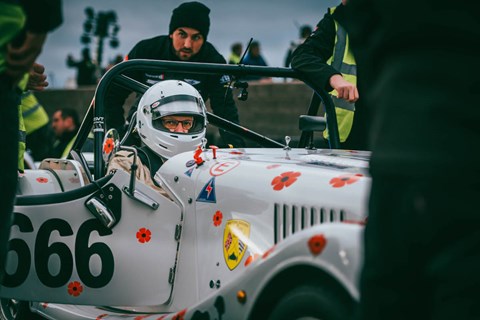
It’s a fun stint, up until a nasty looking accident for one of the quickest cars, a heavily modified Honda Civic Type R. It’s had a big off at the circuit’s fastest point and there’s a lot of debris. The blue lights of the ambulance wink into life and it peels on to the circuit as we trail round behind the Exige safety car. And shortly after, I’m peeling into the pits for a driver-change. All my stints are completed and Tony, Tom and Shane will take it from here – my RoR driving duties are done for 2021.
Thankfully the Honda driver’s okay, and the race is safely underway once more. It puts things in perspective. A sentiment that’s about to become all the more pertinent.
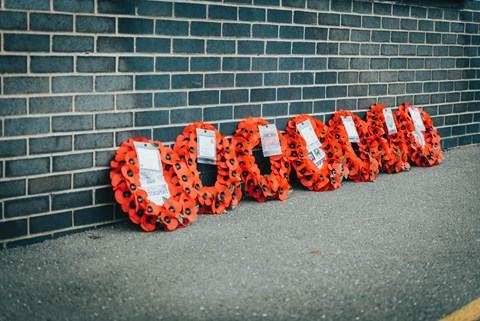
As the clock strikes 10.45am, the Poppy Car rounds up the field and they roll gracefully to a halt on the start line. Drivers exit cars, some racesuits are swapped for uniforms, orders of service are handed round and all present at the circuit assemble in the pitlane for the remembrance service.
As motorsport marshal Emma Featherstone plays the last post on the bugle, it’s against a backdrop of entirely still silence, other than the call of gulls in the sky. Being together with people whose lives have been impacted so significantly in conflict makes the words of the service weigh all the more heavily. It’s profoundly moving.
Service concluded, James Cameron breaks the respectful silence with a resounding cry of ‘let’s go racing!’ Engines once again fire into life, and time unfreezes.
I head to the top of the circuit to watch the action. It’s a clear day and you can see the peaks of Snowdonia across the Menai Strait. And see Lionel smoking car 40’s rear tyre out of Church in a powerslide, on his way to another laptime on a par with the manual car. Setting and sight, it’s inspiring stuff.
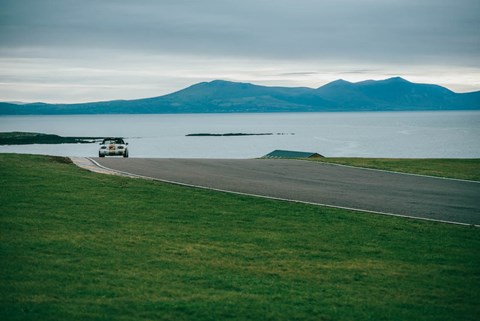
Every aspect of this event is. The Morgan factory team tell me about their first RoR, when they saw an amputee executing a tyre change in a rain-lashed pitstop in the night. Unable to bend down easily to change the wheels, he removed his prosthetics, threw them into the pit garage behind him and scrambled to each corner of the car on the floor. There’s perspective again.
Flag falls and calls time on twelve hours of racing. Rob Boston Racing’s rapidly driven Lotus Elise takes the win by a lap from Giuseppe Felet’s Solo64 team’s Caterham, and become the first recipient of the new ‘Perserverence’ trophy – a giant poppy wrought in reclaimed metal and timber by artist (and former RAF Chinook technician) Jack Taylor. The drivers take home smaller replicas while Perseverance (Percy for short) will return to RoR each year, to be held aloft by the winners.
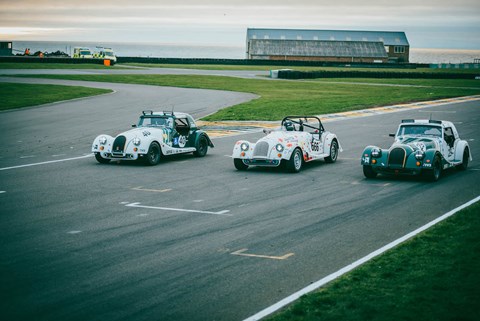
We finish 14th out of 46 finishers – emphatic proof of the Plus Four’s mettle – and three Morgans slow to take the flag in a formation finish, like GT40s at Le Mans. Shane takes the flag in car 29, and Linda, in her first race, in car 40. I can’t imagine a more challenging first experience of car racing: 53 cars on track, in rain, sunshine and pitch-black, navigating traffic, competitor crashes and safety cars in a rapid 250bhp-per-tonne Morgan sports car. Utmost respect. The trio drive alongside each other for a victory lap: John Richards’ poppy-liveried Clubsport in the middle, Plus Fours either side.
Anglesey is a beautiful but bleak place. In the middle of November, all the more so. When you stop and think for a moment, it’s completely irrational to be out in the elements, dicing with other cars, pushing yourself and your competitors to complete 12 hours of intense racing. But there has been plenty of cause to stop and think during this weekend. There are many times, behind the Plus Four’s wheel, when it occurs to me there is nowhere else I’d rather be at that moment. Seeing Snowdonia unfurl on the horizon ahead as we crest the top of the track, seeing smoke curl from the tyres of a car in front as it slides in slow motion – to be able to take part this special sport, and to be a part of this special race, is to feel lucky to be alive and present, on a weekend that celebrates how precious life is. And to be a part of this race is to make you feel life so much more intently.
‘We were very worried before the event, about bringing it back for the first time; it is a huge commitment for us,’ says James Cameron. ‘But it’s paid us back handsomely in the effect that it has. Race of Remembrance has always been about bringing people together.’
Please take a look at the work Mission Motorsport does in more detail here.
Photography by Will Aron and Tom Chapman
With thanks to all Morgan Motor Company, UW Racing, Mission Motorsport, Anglesey Trac Mon – and to Tony, Tom and Shane